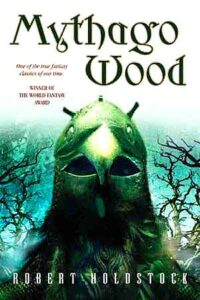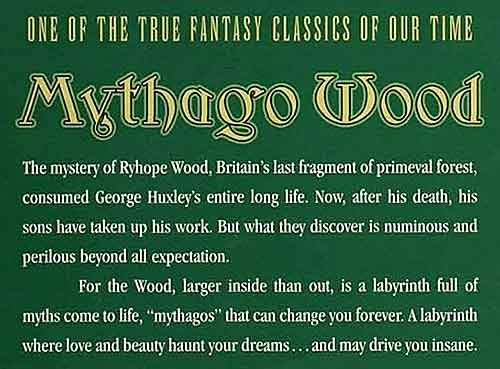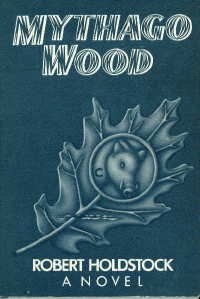By ROBERT HOLDSTOCK (Arbor House; 1984/85)
Here’s a fantasy saga you probably don’t know about, but which rivals most of the others in, if nothing else, sheer volume: the MYTHAGO WOOD cycle by the prolific British novelist Robert Holdstock (1948-2009), which encompassed seven entries (THE LORD OF THE RINGS, by contrast, only managed four), the last of which, AVILION, was published mere months before Holdstock’s demise.
MYTHAGO WOOD, initially published in 1984, was the first Mythago novel. It’s a mighty good book, boasting rich and poetic prose, a well-spun narrative and a thoroughly imagined, multi-faceted fantasy universe. My only complaint is with the fact that the novel doesn’t properly explore its conceptions, leaving that for the sequels, yet still feels overlong.
To elaborate: it was spun off from a novella (published in THE MAGAZINE OF FANTASY AND SCIENCE FICTION in 1981), and while Holdstock did a good job adapting his tale to longform, its origins are still quite evident. I can’t help but feel that the novel’s entire first half, in which the laws and physical properties of the eponymous woodland are established, could have been compressed into a single chapter. Otherwise, however, I agree with most critics, who’ve dubbed MYTHAGO WOOD an unqualified triumph.
The setting is Ryhope Wood, an ancient British wilderness energized by the ever-popular fantasy device (some would say crutch) of ley lines, referring to imaginary lines that apparently denote magical currents flowing through the Earth. Ryhope contains mythagos, meaning people, creatures and objects that emerge from humanity’s subconscious. Said mythagos can only exist within Ryhope, as if they move too far away from it they wither and expire, although they can make trouble for those living on the edge of the wood, as the novel’s protagonist Stephen Huxley, who happens to reside near Ryhope, discovers.
The year is 1946, and Stephen has returned from his WWII military service. Stephen settles into his Ryhope-bordering childhood home with his brother Christian, who’s besotted with the wood and frequently disappears into it. Their deceased father was likewise obsessed with Ryhope, having left behind a collection of writings about the wood that Stephen is drawn to but doesn’t understand.
Eventually, after several odd encounters with mythagos, Christian disappears into the wood. Stephen meets Guiwenneth, a seductive teenage mythago loved by both Stephen’s father and Christian, and Stephen finds himself following suit. This leaves him in a pickle when Guiwenneth is kidnapped by an increasingly mythago-addled Christian and taken with him into the wood, forcing Stephen to follow their trail.
Further interesting elements introduced in this novel include the Urscumug, a bearish monstrosity created by Stephen’s father, and the Lavondyss, an apparently paradisal region of Ryhope Wood that’s talked about but never explored. That exploration, I’m guessing, takes place in the 1988 sequel LAVONDYSS, which I’ll clearly have to read.



